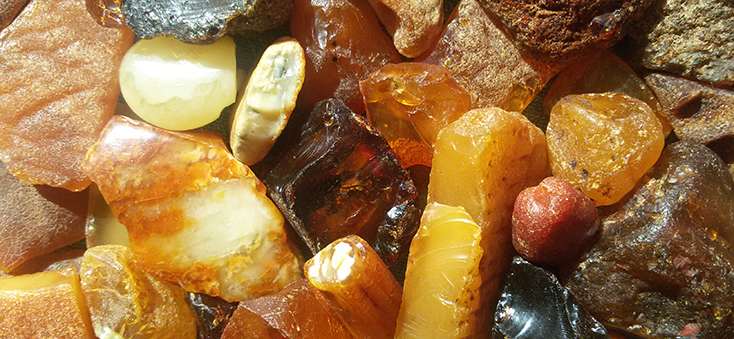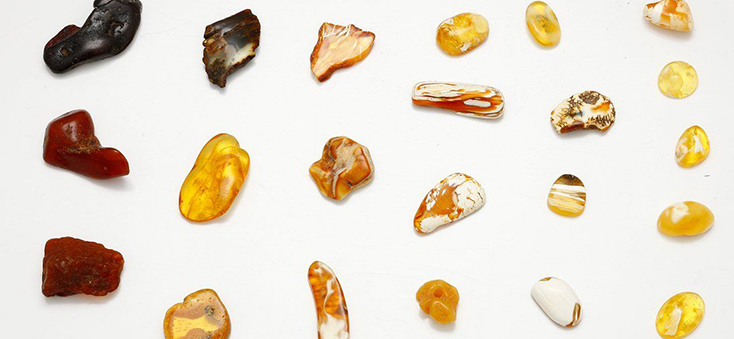The magical gamut of nature - what is amber like?
The usual shades that the sunstone plays with are yellow, orange, and orange. They have become part of proverbs and sayings - wine, ripe fruit, sweet caramel, and sometimes the hair of beautiful blondes is equated with radiant gems. However, in reality, the range of hardened resin is much wider - and our article will introduce you to its most amazing varieties on yantar.ua web!

Analysis and evaluation - ancient classifications of amber
People have long sought to study and systematize the surrounding world. The mysteriously shimmering pebbles found on the Baltic coast and in Polish forests were no exception. Archaic naturalists asserted that they came from lightning, "emanations of the ether" (magical impulses from a celestial body), tears of a sea goddess, secretions of wild animals, or the juice of fantastic fruits. Medieval Arabs believed that cabochons were sent from heaven as a divine gift. Even in the Age of Enlightenment, a French thinker wrote that beautiful gems arise from solidified bee honey!
Why did researchers put forward such creative hypotheses? Most likely, they were confused by the variety of hardened resin - it can be bright and pastel-pale, uniform or speckled with myriads of inclusions, clear as crystal, and cloudy. The color is just as rich - amber covers the entire visible range, from white to anthracite-black.
However, despite the difficulties, scientists managed to establish the truth. Already Aristotle, Theophrastus (a Greek philosopher and botanist who lived in the 4th century BC), and Pliny the Elder (a Roman scholar, the author of "Natural History") came to the conclusion that precious stones appeared from the sap of coniferous trees. In the 18th century, their theory was confirmed by Carl Linnaeus (Swedish physician and biologist who organized the nomenclature of animals and plants) and Mykhailo Lomonosov (Russian encyclopedist, physicist, and chemist).

They determined the main characteristics of gems - melting at a temperature of 180-220C or a pressure of 30-60 MPa (from 300 to 600 kg/cm2), a tendency to photoaging (changes in tone during prolonged exposure to direct sunlight), relative fragility, resinous luster and fracture toughness.
Trial attempts to sort the solidified resin were made in 1763. In the treatise of Ivan Schlatter (mining expert and metallurgist), information about "flaky, smoky, watery, and pumice" types is presented. In 1807, academician Vasyl Severgin provided a similar summary, but as a central criterion, he chose the color of cabochons (nuggets cleaned of extraneous impurities) - white, ocher, reddish, etc. And in 1882, the Prussian geologist Richard Klebs published an essay on inclusions (representatives of flora and fauna that got into amber; the price of such rarities exceeds tens of thousands of dollars), along the way discovering several classes of stones that are still used by jewelers. But still, these standardizations were incomplete and based only on the external properties of gems.
Modern typologies
According to the data of the International Mineralogical Association (International Mineralogical Association), fossil resin aged from 100 to 23 million years, which is used in decorative and applied arts, is called amber. There are many such precious stones - in a 1974 monograph, about 30 objects are listed, from ambrite to electron. What is their difference?
The most general system is organized according to the territorial principle - depending on where the gems were found:
- Baltic cabochons are from a region spanning Germany, Poland, Lithuania, Latvia, Estonia, Denmark and Sweden. One of the oldest and thoroughly explored deposits with a huge potential - up to 500 tons per year. Stones from there were imported to Egypt, Persia, and Sumer in antiquity. They have a unique structure - a molecular mesh with transverse links, which ensures durability and a rich shade;
- Ukrainian hardened resin from Rivne, Volyn and Zhytomyr regions. It contains healing succinic acid and essential essences, and in increased doses - 3-8% of the mass, insects unknown to science (beetles, flies, mosquitoes, butterflies), needles, twigs and cones of their "ancestors" - giant, now extinct Pinus succinifera pines;
- Simetites from France, Spain and Sicily were formed from the resin of tropical angiosperm vines, which has a lot of iron - because of it, cabochons shimmer with magical crimson, purple, and purple highlights. Gems from Romania (rumenites) have identical composition, but the proportion of sulfur makes them darker - from deep brown to black;
- Amber in Africa (Lebanon, Tanzania, Ethiopia) is older than its counterparts - from 130 to 135 million years. It is very fragile, but the resin hides truly incredible surprises: an archeopteryx feather or the head of a miniature dinosaur;
- In the Western Hemisphere, precious stones were mined in Canada, Alaska, Washington, Kansas, New Jersey, Montana, and California. Cherry-red cabochons are characteristic of the state of Chiapas (Mexico), and "opal", blue-green and phosphorescent in the dark - for the Dominican Republic (Haiti);
- In addition to the famous Kaliningrad mines, amber soils in Russia have been discovered in Taimyr, the Urals, Sakhalin and Kamchatka. Almost all gems were brought there by glaciers during the Cenozoic Ice Age (20-30 million years ago) and scattered along riverbeds;
- In Asia, amber is successfully sought in Mongolia, China, Japan, Indonesia and Myanmar (Burma). Red specimens are highly valued there - they are respectfully called "dragon's blood". It is believed that such decorations and souvenirs endow the wearer with good health, wisdom, courage and foresight;
- A couple more deposits are in England (in the counties of Kent, Essex and Suffolk), New Zealand and Greenland (dragonflies, ants and scolopendras hide in them, which indicates the warm, humid climate that once prevailed on the cold island).
If we analyze precious stones from the point of view of chemistry, then they are non-crystalline (amorphous) mineraloids - substances in which organic compounds have fossilized over the years, that is, changed to inorganic ones. According to how they interact with other elements, the following are distinguished:
- real succinite (from the Latin word "succinum" - "amber"). Viscous and refractory (hardly penetrated by a red-hot needle), with a low specific gravity - does not sink in salt water, optimal for making accessories;
- retinitis. Lying next to layers of lignite, weak and dull, but in demand in industry and instrument making;
- relatively "young" resins, from which varnishes, paints, fertilizers, food additives and vitamins are obtained.

The largest first group includes gems from the Baltic States, Ukraine, and Saxony. Therefore, it was necessary to mark the following categories:
- Actually succinites, they are "royal amber" - of impeccable quality;
- Glesites are succinites that have become brittle and contaminated due to adverse conditions;
- Hedanites (swamp or rotten cabochons) - formed as a result of weathering, covered with a thick crust of oxides. The palette is muted, dirty and earthy;
- Stantienites – They can be confused with coal, but the dark stones emit a soft blue or ruby glow. Due to the fact that up to 90% of such gems are destroyed in the mining process, this is a rare and desirable treasure for collectors - Carl Faberge himself decorated his masterpieces with them;
- Beckerites are rough, dull beige and terracotta;
- Kranzites are greenish-chestnut and plastic (squeezable with a finger), which is why they are known as "immature" amber.
It is also important how the gum flowed and what happened to it afterward. Based on this parameter, the following are distinguished:
- Drops (diameter 2-3 cm) – round and smooth, sometimes slightly flattened – from falling down;
- Intrusions are elongated, with overlapping layers, when the upper one slowly covered the already solidified lower one, repeating the topography of the crust. On average, no more than 5-20 cm, but a 10 kg sample is stored in the Berlin Museum of Natural History;
- Icicles, or stalactites - were born when wood was damaged, when it was abundantly oozing with resin, and hung freely from the branches;
- Internal accumulations are clots in the cavities of the trunk, which later turned into large tubers, plates and lenses with an arc-shaped cross section.
Types of amber by color and texture
Guided by the range of precious stones, recognize:
- The batter is completely clear, with clearly visible inclusions, the range of tones from lemon to mustard. Excellent for polishing, carving, grinding;
- Flom (cloudy) - with alternating transparent and matte areas. Its close "relatives" are landscape cabochons with colorful patterns, spots and abstract ornaments;
- Bastard is heterogeneous, it resembles frozen fat or thick nectar. And air bubbles in it create magical patterns;
- Knoken - bone or milk gems resembling ivory;
- Layered, greasy, overburden stones - with varying degrees of transparency, but equally unsuitable for processing;
- Foamy hardened resin - cream or oily yellow, porous, similar to pumice.
Translucent cabochons (in which various foreign bodies occupy up to 30% of the volume) and opaque cabochons, where less than half shines through, are distinguished by the level of light transmission.
Now that you know all the secrets of golden stones, you should buy amber products from our authentic brand!